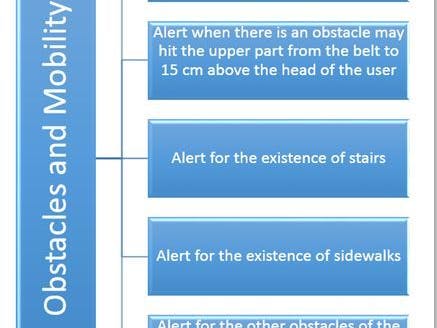Globally, it is estimated by the World Health Organization (WHO) that 40 to 45 million people are totally blind and 314 million have some kind of visual impairment. In Egypt, 800,000 suffer from blindness. It is estimated by 2020, all blind-related numbers will double. According to several studies, the most urgent and important problem for them is their physical mobility and the autonomous walking.
The aim of this project is to provide an integrated electronic travel aid for blind’s mobility, with a low cost, that covers the blind’s requirements to do what it needs to navigate, move and travel independently and safely.
The introduced electronic travel aid is an integrated assistive belt consists of three major parts: dealing with the obstacles from different aspects and guiding according to them, localization system for navigation, and emergency SMS in case of getting lost or needing help. All the given feedbacks are hearable or tactile to achieve the user requirements according to the nature of the blind’s senses. In addition, all of the parts that need an input order work by voice commands.
Step 1: The advantages of the project to the blind (the applications)
Step 2: The required materials
Step 3: Making attachments and covers for the safety and the stability
For the safety and the stability of the prototype, covers for the ultrasonic sensors- to protect the sensors and attach them to the belt- and a cover box for Arduino board and 1Sheeld have been made. The designs have been made using Coral Draw program, and then they have been cut using the LASER Cutter machine in STEM FabLab. They are made according to the dimensions shown in the sketch.
Step 4: Setting the ultrasonic sensors for the safe distance
X1 is the distance from the belt to the ground. X2 is the distance from the belt to 15 cm above the head of the blind. They differ according to the blind’s body. Consequently, Y1 and Y2 change which are the distances that the sensor detect any object less than them. That makes a safe distance Z1 and Z2 in front of them. The angels θ1 and θ2 are 30°and 10° respectively. The numbers used in this prototype are as shown in the table.
Step 5: Making the electronic circuit
The components of the circuit are connected as follows:
- 1Sheeld component is connected and put on the Arduino board.
- The ultrasonic sonic sensor has 4 pins for each of the five sensors: Power, Ground, Trigger and Echo. All of the Power pins are connected to each other to the Vcc output, and the same goes with the ground pins to the GND output. The Trigger and Echo pins are connected each one to one pin in Arduino board (Pins: 13:7 and 4:2).
- The vibration motor has 2 terminals for each of the two motors. One terminal at each motor is connected to the GND. The other terminal at each motor is connected to the emitter pin of an NPN transistor. The collector pin of each transistor is connected to GND. The base of each transistor is connected to 1K Ohm resistor and the other terminal of the resistor is connected to pins (5:6) in Arduino board.
- All the Vcc pins are connected with one wire to the output Vcc of the Arduino board and all the GND pins are connected with one wire to the output GND of Arduino board
Step 6: The PCB
Moving to the printed circuit board, the previous circuit has been designed, to be PCB for the product, using Eagle program and made using the Modela machine. Then, by using the soldering machine, the components and wires have been connected to the board.
Step 7: The final appearance for the prototype
Finally, the materials have been attached and connected to the belt as shown. A bag for covering the box of the Arduino UNO and 1Sheeld has been connected to the belt. This bag also has some pockets for the battery, the smartphone and the power bank.
Step 8: Plan for the future
I thought of combining an app, which is able to benefit from the GPS more than getting the pinpoint, with 1Sheeld app. That app, using maps systems, will make it better to navigate from place to another through temporary maps, detecting the neighboring stations, restaurants, traffic lights, etc. but just by audible words and with the developed integrated help according to the intercepting obstacles. If anyone can help and cooperate, he or she will be more than welcomed :) !
Ahmed Adel Gomaa



_ztBMuBhMHo.jpg?auto=compress%2Cformat&w=48&h=48&fit=fill&bg=ffffff)





Comments
Please log in or sign up to comment.